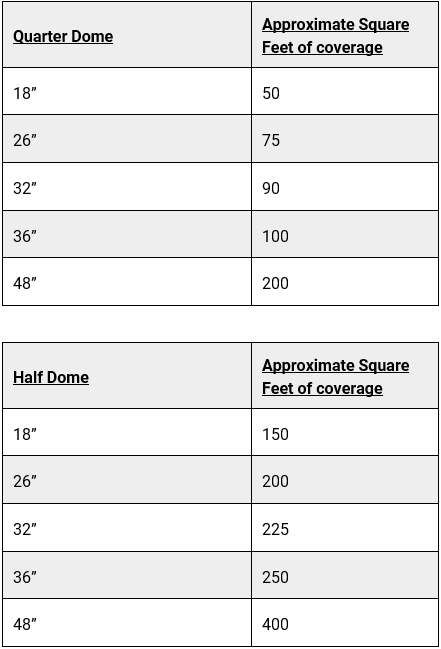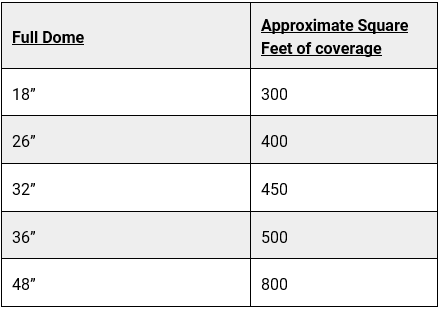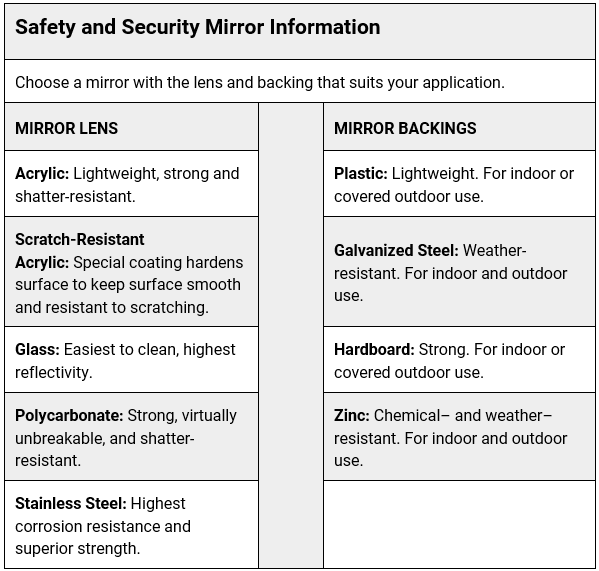Security Mirrors – Quick Tips
Using mirrors to help provide a safe and secure work environment is good practice. When positioned appropriately, security mirrors alert personnel of danger or theft. These mirrors are also useful in factories where foot and forklift traffic can cross paths, in offices where blind intersections and corners exist and at front desk/office locations where individuals need to view normally blocked access areas.
Security mirrors come in four styles – convex, dome, flat panel and inspection. The most commonly asked security mirror questions are what style of mirror is best, what material of construction should be selected and where should the mirror(s) be placed for optimal viewing.
Here we will take a closer look at convex, dome and flat panel security mirrors, what they are best used for and how to determine what mirror will be best suited to your application.
Convex Mirrors
If an application calls for the need to view objects in some detail at distances of roughly 15 to 20 feet, then a convex mirror is suggested. A convex mirror has a curved mirrored surface that allows for the reflective surface to project toward a light source. Convex mirrors reflect light outwards, they are not used to focus light, and therefore act similar to that of a standard mirror. Convex mirrors form a virtual image of reflection since the focus and the center of curvature are both imaginary points inside of the mirror. When trying to view and pinpoint a particular area, use a convex mirror. Since the lens of a convex mirror is curved less than that of a dome style mirror, the image in the convex mirror appears larger and less distorted. Convex safety mirrors allow for up to 180 degrees of vision, and can be used to view at an angle to reduce accidents around blind corners and doorways. As an example, convex mirrors are effective when viewing aisle traffic in a store or warehouse. In the Occupational Safety and Health Administration’s (OSHA’s) Powered Industrial Truck eTool, it’s recommended that convex mirrors be installed at blind aisle intersections.
Convex mirrors are offered in circular or round rectangular shapes. Round rectangular convex mirrors are an ideal choice where hanging in low ceiling areas is necessary. Convex mirrors come in several materials and can be used for both indoor and outdoor applications.
Dome safety and security mirrors offer a panoramic view of an area. Typically for indoor use. dome mirrors help eliminate blind spots and increase visibility at a broader angle than convex mirrors. Dome mirrors are available in full, half, and quarter dome models. Dome mirrors are effective when used to view wide areas where the objects that need to be clearly viewed are no more than 15 to 20 feet away. A dome mirror lens is curved more than the convex mirror lens. The curvature allows for a wider angle of vision. Dome mirrors provide an infinite reflection; however, the further away a person is from the mirror the smaller the objects will appear. If the selected dome mirror is too small or positioned too far away for observation, the objects will appear so small that they are virtually unidentifiable. This is due to the curvature of the dome lens and the relatively short height/depth ratio on a dome mirror. The larger the mirror, the larger the objects will appear.



- For small offices and “L” shaped hallways, a 90 degree “quarter dome” mirror can be used.
- When viewing blind corners and “T” intersections, a 180 degree “half dome” mirror can be used.
- For areas that require visibility at a four-way intersection or visibility from all angles a 360 degree “full dome” mirror is a best option.
Choosing the Correct Mirror Size
It is important to select the proper size mirror for the area where it will be used. A mirror that is too small will not provide sufficient viewing distance, detail and visibility. The larger the mirror size, the larger the reflected image will appear.
When determining the size of convex mirror, a good rule of thumb to remember is, one foot of viewing per each inch of mirror. As an example, if planning on placing a convex mirror into an area that is expected to view 25 feet, then select a convex mirror that is 26” in diameter.
The following are factors to take into account when choosing the right dome mirror:
- The distance in feet you will be standing or positioned from the mirror.
- How far away from the mirror are the objects you wish to view (distance in feet).
- How clearly you need to see the objects reflecting in the mirror. Do you need to just make out movement, or do you need to see clearly enough to recognize objects or people in greater detail?
- The larger the mirror, the larger the objects will appear in the mirror. Full domes offer the most robust view, followed by half domes, and then quarter domes.


Flat Panel Mirrors
For distortion free viewing flat panel security mirrors provide the optimum solution. They are ideal for use in suspended ceilings, ceiling panel inserts, or on walls. These mirrors are capable of offering a viewing of an immediate area. A two-way version of this type of mirror can be used for an overhead observation area or with a security camera. Simply replace the existing acoustical ceiling panel with the mirrored two- way panel.
For inspection and viewing under and around vehicles, machinery and equipment, inspection mirrors offer features such as telescoping poles, with flashlight attachments, wheels and pivoting heads that can be angled to see into hard to reach areas. Inspection mirrors can be used indoors as well as outdoors.
Mirror Construction Materials

Commonly Asked Questions
Q: What is the difference between an Indoor Mirror and an Outdoor Mirror?
A: Typically outdoor mirrors will be convex; Grainger offers both indoor as well as outdoor convex mirrors. The material that the mirror is constructed of will determine if the mirror should be used outdoors or not. Certain materials cannot withstand the elements. For example, mirrors with hardboard backings are generally insufficient for outdoor applications. It is best to review the materials your convex mirror is constructed out of or check with the mirror manufacturer before deciding to mount the mirror outdoors. Additionally, dome mirrors are intended for indoor use only.
Q: How high should I mount my security mirrors?
A: Recommended mounting height for security mirrors, in most cases is 8 to 10 feet. You want them low enough to view but not so low that they become an obstruction. For low overhead clearance mounting, a rectangular convex mirror can be used.
Q: How should I clean my security mirrors?
A: Proper cleaning and caring for your security mirrors will keep the mirror in good shape for viewing. In order to avoid scratching your mirror surface, and to keep the mirror in good quality condition, it is best to contact the manufacturer for instructions on cleaning the mirror.
Sources
The information contained in this article is intended for general information purposes only and is based on information available as of the initial date of publication. No representation is made that the information or references are complete or remain current. This article is not a substitute for review of current applicable government regulations, industry standards, or other standards specific to your business and/or activities and should not be construed as legal advice or opinion. Readers with specific questions should refer to the applicable standards or consult with an attorney.
Source: Grainger Know How – https://www.grainger.com/know-how